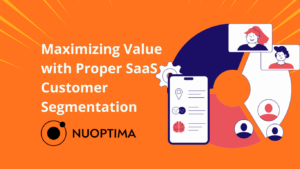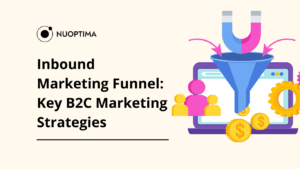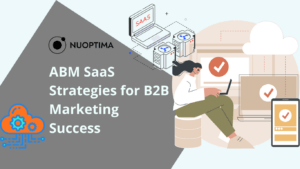In the rapidly evolving world of Business-to-Business (B2B) Software as a Service (SaaS), metrics are the compass that guides decision-making, strategy, and growth. B2B SaaS metrics are quantifiable measures that provide insights into various aspects of a business, such as customer behavior, financial performance, product usage, marketing effectiveness, and overall business health.
As an award-winning B2B SaaS SEO agency, we understand the key metrics you should be tracking and how to use them to grow your software business. Read on to learn how these metrics are not just numbers on a dashboard; they are vital tools that enable SaaS companies to understand their customers, optimize their products, align with market trends, and ultimately drive success.
For a deep dive into advanced analytics strategies, listen to the Nuoptima SaaS Podcast featuring Dennis Hu from Drug Hunter.
Overview of the Current Landscape and Trends in B2B SaaS
The B2B SaaS industry has seen exponential growth, with emerging trends such as:
- AI and Machine Learning: Predicting customer behavior.
- Customer Health Scoring: Assessing satisfaction and churn risks.
- Real-time Analytics: Providing instant insights.
- Integration with IoT: Enhancing product insights.
Key Metrics for B2B SaaS Companies
Understanding and tracking the right metrics is crucial. Here’s a breakdown of key metrics:
Product Usage Metrics
- Active Users: DAU, MAU, WAU.
- Retention Rate: Customer loyalty over time.
- Engagement Score: Interaction with the product.
- Adoption Rate: Utilization of features.
- Time to Value: Speed at which users gain benefits.
Financial Metrics
- MRR/ARR: Monthly/Annual Recurring Revenue.
- Churn Rate: Percentage of customers lost.
- LTV: Lifetime Value of a customer.
- CAC: Customer Acquisition Cost.
- Conversion Rate: Percentage of leads converted to customers.
Marketing Metrics
- Lead Generation: Number of new potential customers.
- SEO Ranking: Search engine visibility.
- Social Engagement: Interaction on social media platforms.
Customer Success Metrics
- NPS: Net Promoter Score, customer satisfaction level.
- Customer Health Score: Overall satisfaction and engagement.
- Customer Retention Rate: Percentage of customers retained.
Sales Metrics
- Sales Cycle Length: Time to close a sale.
- Lead Conversion Rate: Percentage of leads converted to sales.
- Quota Attainment: Meeting or exceeding sales targets.
Metrics Across Different Stages of Growth
Different stages of growth require different metrics:
| Stage | Key Metrics | Focus Area |
| Startups | MRR, Churn Rate, CAC, Lead Generation | Growth, Customer Acquisition |
| Scale-ups | LTV, NPS, Sales Cycle Length | Expansion, Customer Satisfaction |
| Established | ARPU, Retention Rate, SEO Ranking | Sustainability, Market Presence |
Metrics for Different Subscription Models
Different subscription models have unique metrics:
- Freemium: New signups, Retention, Conversions, Revenue (MRR), Engagement.
- Trial-based: New trials, Engagement, Adoption, Conversions, Revenue converted.
- Subscription-based: Churn rate, LTV, CAC, MRR/ARR.
Data-Driven Decision Making
Utilizing tools like Google Analytics, Mixpanel, and Tableau, companies can collect and analyze data to make informed decisions.
Aligning Metrics with Business Goals
Aligning metrics with business goals ensures that the company is on the right track. For example, if the goal is to increase customer retention, focusing on metrics like NPS and Customer Retention Rate is essential.
Customer-Centric Approach
Understanding customer behavior and needs is crucial. Personalization and segmentation strategies can enhance customer experience.
Qualifying and Converting Leads
Strategies for converting trial users to customers include:
- Providing desired outcomes.
- Delivering promises.
- Understanding the “Aha! Moment.”
Deep Dive into B2B SaaS Metrics
Active Users: DAU, MAU, WAU
| Definition: | DAU (Daily Active Users): The number of unique users who engage with a product within a single day.MAU (Monthly Active Users): Unique users who engage over a month.WAU (Weekly Active Users): Unique users who engage over a week. |
| Importance: | Active user metrics provide insights into user engagement and product stickiness. A high DAU/MAU ratio indicates strong daily engagement. |
| Example: | If a SaaS tool like Slack has 1,000 MAU and 500 DAU, it means that on average, 50% of their monthly users are using the product daily. |
| Actionable Insight: | Low DAU/MAU ratios can indicate that users aren’t finding daily value in your product, signaling a need for improved user engagement strategies. |
Retention Rate
| Definition: | The percentage of customers who continue to use a product over a given period. |
| Importance: | Retention rate is a direct indicator of product value and customer satisfaction. High retention means customers find consistent value. |
| Example: | If 80 out of 100 users from January are still active in February, the monthly retention rate is 80%. |
| Actionable Insight: | Low retention rates can indicate issues with product functionality, market fit, or customer support. |
Engagement Score
| Definition: | A metric that quantifies user interaction and activity levels with a product. |
| Importance: | It helps in understanding how deeply users are involved with the product features. |
| Example: | A user who logs in daily, shares documents, and participates in discussions might have a higher engagement score than a user who only logs in occasionally. |
| Actionable Insight: | Identifying features that drive high engagement can guide product development and marketing strategies. |
Adoption Rate
| Definition: | The percentage of users who adopt a new feature or product. |
| Importance: | Indicates the success of feature launches and product updates. |
| Example: | If a CRM tool introduces a new analytics dashboard and 700 out of 1,000 users start using it within a month, the adoption rate is 70%. |
| Actionable Insight: | Low adoption rates for new features can signal a need for better user education or feature adjustments. |
Time to Value (TTV)
| Definition: | The duration it takes for a user to achieve their first significant positive outcome with a product. |
| Importance: | A shorter TTV can lead to higher user satisfaction and retention. |
| Example: | If a user can set up and run their first email campaign using a marketing tool within 2 hours, that’s the TTV. |
| Actionable Insight: | Streamlining onboarding processes and providing clear user guides can reduce TTV. |
MRR/ARR
| Definition: | MRR (Monthly Recurring Revenue): Predictable revenue that a company can expect every month.ARR (Annual Recurring Revenue): Predictable revenue that a company can expect every year. |
| Importance: | Key indicators of a company’s financial health and growth trajectory. |
| Example: | If a company has 100 customers, each paying $50/month, the MRR is $5,000. |
| Actionable Insight: | A declining MRR can indicate increasing churn or reduced new sales, signaling a need for intervention. |
Churn Rate
| Definition: | The percentage of customers who stop using a product over a given period. |
| Importance: | Directly impacts revenue and indicates customer satisfaction. |
| Example: | If 10 out of 100 users cancel their subscriptions in a month, the monthly churn rate is 10%. |
| Actionable Insight: | High churn rates can indicate product issues, market misfit, or competitive disadvantages. |
LTV (Lifetime Value)
| Definition: | The total revenue a company can expect from a single customer over the duration of their relationship. |
| Importance: | Indicates the long-term value of customers and helps in determining the cost-effectiveness of acquisition strategies. |
| Example: | If a customer subscribes for an average of 2 years and pays $500/year, the LTV is $1,000. |
| Actionable Insight: | Increasing LTV can be achieved by improving retention, upselling, or raising prices. |
CAC (Customer Acquisition Cost)
| Definition: | The average expense of acquiring a single customer, including marketing, sales, and overhead costs. |
| Importance: | Directly impacts profitability. A lower CAC indicates cost-effective acquisition strategies. |
| Example: | If a company spends $5,000 on marketing and acquires 100 customers, the CAC is $50. |
| Actionable Insight: | If CAC exceeds LTV, the company is losing money on every customer and needs to adjust its strategies. |
Conversion Rate
| Definition: | The percentage of leads or visitors who take a desired action, such as signing up or making a purchase. |
| Importance: | Indicates the effectiveness of marketing and sales strategies. |
| Example: | If 100 visitors visit a signup page and 20 sign up, the conversion rate is 20%. |
| Actionable Insight: | Improving website design, offering incentives, or optimizing ad targeting can boost conversion rates. |
Case Studies and Real-World Examples
Understanding how successful companies utilize B2B SaaS metrics can provide valuable insights and inspiration. Here are some in-depth case studies that showcase the application of these metrics in real-world scenarios:
Dropbox: Leveraging User Engagement Metrics
Challenge: Dropbox needed to understand how users were engaging with their file-sharing platform to drive growth and reduce churn.
Strategy: They focused on tracking DAU, MAU, and user engagement scores, identifying key features that drove daily usage.
Outcome: By optimizing these features and introducing referral programs, Dropbox increased its user base from 100,000 to 4 million in just 10 months.
Key Takeaway: Understanding user behavior and focusing on engagement can lead to exponential growth.
Slack: Utilizing NPS to Enhance Customer Satisfaction
Challenge: Slack wanted to ensure high customer satisfaction levels to foster loyalty and word-of-mouth referrals.
Strategy: They implemented regular Net Promoter Score (NPS) surveys to gauge customer satisfaction and identify areas for improvement.
Outcome: By acting on customer feedback and enhancing user experience, Slack achieved an NPS of 70+, well above the industry average.
Key Takeaway: Regularly measuring and acting on customer satisfaction metrics can create loyal customers and brand advocates.
HubSpot: Optimizing Lead Conversion Metrics
Challenge: HubSpot needed to increase the efficiency of its marketing efforts to convert more leads into paying customers.
Strategy: They tracked lead conversion rates, CAC, and time-to-conversion, implementing A/B testing and personalized marketing campaigns.
Outcome: HubSpot increased its conversion rate by 10% and reduced CAC, leading to higher profitability.
Key Takeaway: Focusing on conversion metrics and personalization can optimize SaaS marketing ROI.
Salesforce: Aligning Metrics with Business Goals
Challenge: Salesforce wanted to align its vast array of metrics with specific business goals to drive focused growth.
Strategy: They identified key metrics for different business units, such as MRR for sales, churn rate for customer success, and engagement score for product development.
Outcome: This alignment led to a more cohesive strategy across the organization, resulting in a 25% increase in annual revenue.
Key Takeaway: Aligning metrics with business goals ensures that every part of the organization is working towards common objectives.
Zoom: Real-time Analytics for Rapid Decision Making
Challenge: Zoom needed to make quick, data-driven decisions during the pandemic to handle the sudden surge in users.
Strategy: They implemented real-time analytics to monitor system performance, user behavior, and feature adoption.
Outcome: This enabled Zoom to quickly scale its infrastructure, introduce new features, and maintain a high-quality user experience during a period of unprecedented growth.
Key Takeaway: Real-time analytics can empower a company to make agile decisions in a rapidly changing environment.
These case studies provide tangible examples of how B2B SaaS metrics can be applied to solve real business challenges, drive growth, and create competitive advantages. They demonstrate the versatility and power of metrics in shaping successful strategies and achieving remarkable outcomes. Whether it’s leveraging user engagement like Dropbox or focusing on real-time analytics like Zoom, these examples offer valuable lessons for any SaaS company looking to thrive in today’s market.
Challenges and Common Mistakes in B2B SaaS Metrics
Understanding the potential pitfalls and challenges in B2B SaaS metrics is crucial to avoid missteps and ensure accurate, actionable insights. Here are some common challenges and mistakes, along with their implications and solutions:
Misinterpreting Metrics
| Challenge | Metrics can sometimes be misleading if not understood in context. |
| Implication | Making decisions based on misinterpreted data can lead to wasted resources and missed opportunities. |
| Solution | Ensure a clear understanding of each metric’s definition and context. Regularly train teams on metric interpretation. |
Focusing on Vanity Metrics
| Challenge | Vanity metrics look good on paper but don’t necessarily correlate with business success. Examples include total sign-ups without considering active users or page views without engagement data. |
| Implication | Relying on vanity metrics can give a false sense of success and divert attention from more critical metrics. |
| Solution | Prioritize actionable metrics that directly impact business goals. Regularly review and adjust metric focus. |
Ignoring Customer Feedback
| Challenge | While quantitative metrics provide valuable data, ignoring qualitative feedback from customers can lead to missed insights. |
| Implication | Not addressing customer pain points can lead to increased churn and negative word of mouth. |
| Solution | Regularly collect and analyze customer feedback. Integrate this feedback into product development and strategy. |
Not Aligning Metrics with Business Goals
| Challenge | Metrics that aren’t aligned with business objectives can lead to misdirected efforts. |
| Implication | Resources might be wasted on initiatives that don’t drive business growth. |
| Solution | Regularly review and align metrics with overarching business goals and objectives. |
Over-reliance on a Single Metric
| Challenge | Solely focusing on one metric, like MRR or churn, without considering other related metrics. |
| Implication | A narrow view can miss the bigger picture, leading to incomplete strategies. |
| Solution | Adopt a holistic approach. Consider a dashboard of related metrics to get a comprehensive view. |
Not Regularly Reviewing and Updating Metrics
| Challenge | As businesses evolve, the metrics that were once crucial might become less relevant. |
| Implication | Outdated metrics can lead to strategies that don’t align with current business needs. |
| Solution | Regularly review and update metrics to ensure they remain relevant and actionable. |
By being aware of these common challenges and mistakes, B2B SaaS companies can be better equipped to navigate the complex landscape of metrics. It’s essential to approach metrics with a critical eye, ensuring that they provide real value and actionable insights that align with business objectives. Whether it’s avoiding the allure of vanity metrics or ensuring metrics are understood in context, these insights offer a roadmap to metric success.
Future Trends and Predictions
Future trends include the integration of AI in analytics, predictive modeling, and the use of augmented reality in product engagement.
Best Practices and Tips
- Keep metrics simple.
- Prioritize key metrics.
- Regularly review and adjust.
Conclusion
B2B SaaS metrics are essential for understanding, optimizing, and growing a business with the guidance of a SaaS PR agency. By focusing on the right metrics, utilizing the best tools, and aligning with business goals, SaaS companies can thrive in a competitive landscape.
Resources and Tools
- Analytics Tools: Google Analytics, Mixpanel, Tableau.
- Customer Feedback Tools: SurveyMonkey, Typeform.
- Financial Tracking Tools: QuickBooks, FreshBooks.



